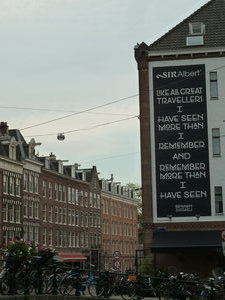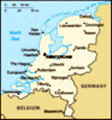Advertisement
Published: July 17th 2015

 Amsterdam
Amsterdam
The quote that every traveler in Amsterdam needs. While I was aware and prepared for the aspects of Amsterdam’s reputation that had kept me away from the city thus far, I was not prepared for its overwhelming beauty, richly interactive history and patient hospitality. Amsterdam is a city filled with historic cafes, picturesque canals, beautiful architecture and surprisingly reasonable food and drink, particularly after Stockholm. Although we tried to explore the various neighborhoods we spent quite a bit of time in the Medieval Center, as it was close to where we were staying, and which ended up being my favorite part of town, always lively and quite beautiful. Le Maroxidien, a small houseboat bed & breakfast not far from Central Station, comes highly recommended for its location, lovely décor, reasonable tariff, delicious organic breakfast and of course the kindness and conviviality of its owner, Kathrin. The only people who shouldn't consider staying are those with mobility issues, as you must climb across another houseboat and descend a small ladder to get to your room. We stayed in the India room, the smallest one available, and again, it was lovely and an excellent overall experience.
If you're headed to Amsterdam, I advise that you plan ahead for

 Amsterdam canal
Amsterdam canal
Lovelier and lovelier...the big museums and popular sights and buy your tickets in advance, as the queues can get long as the day progresses and crowding can be an issue. As with any well-visited city, if there's a sight you want to see, go early. This is most essential for the Anne Frank house; get your timed ticket online in advance, otherwise you will need to arrive by 8 am in order to get in at a reasonable time, say 9:30 am or so. It will be crowded no matter what time you go but the wait only gets longer – and longer, and longer. There are also sights you can safely skip, such as the Westerkerk – it's much more impressive from the outside – and the Bloemenmarket, which, despite the glowing Lonely Planet recommendation is not impressive and bulbs cannot be brought to the US until late summer anyway. Instead, head to the Tulip Museum for bulbs (when available) and some lovely tulip-themed souvenirs when they aren't. The Reypenar cheese tasting is worth it if you enjoy cheese – wine is included and you will get a discount in the store for your cheesy gifts. An afternoon at the Sauna

 B&B Le Maroxidien
B&B Le Maroxidien
The India Room. If you're staying overnight in Amsterdam you should look into reserving a room at the B&B Le Maroxidien - highly recommended. Deco in the Western Canal Ring is something that I missed this trip but still feeling confident in recommending based on the reviews on other sites. Also, be sure to try the frites at Vleminckx friteshuis – the best in the city and accompanied by plenty of delicious sauces (try the peanut and mayo); I also saw positive reviews of Wil Graanstra friteshuis but it was closed the day I tried to visit. If you're looking for something more deliciously upscale, I hear good reports about Ron Gastrobar, off the south end of Vondelpark. Otherwise there are many serviceable Indonesian restaurants and several spots selling sweet and savory pancakes. Most especially, my recommendation to you is to leave plenty of time for long visits to the brown cafes that dot the city, as then you'll get a good drink, a dose of history and a chance to converse with some very interesting characters. There's no better way to spend an afternoon or evening in Amsterdam. The drink to try here is jenever, the juniper-flavored precursor to gin so popular in this region, which is available at cafes and bars as well as tasting houses. The most atmospheric of these, in

 B&B Le Maroxidien
B&B Le Maroxidien
Tea, coffee and snacks on offer all day, but of course you'll be out on the town. The daily organic breakfast, not featured here, is delicious. my opinion, is Wynand Fockink, which began as a distillery in the 1670s, and today has not only jenever but a wide range of flavored liquors. The personable Marjam will help you to find something you like, and will school you in the importance to leaning over to take the first sip from the over-flowing glass. In de Olofspoort, a drinking haven since 1618, is also a good spot to stop, central yet not overrun. Finally, the Proeflokaal de Ooievaar, another lovely bar from 1782 located near the Central Station, is a lively place to while away a few hours. All come highly recommended.
We started our first full day at the Rijksmuseum, an impressive building housing an impressive collection. There were the expected Rembrandts and other Dutch masters as well as a modest selection of late-20th century works. My appreciation of Dutch painting increased considerably, although the museum itself was quite large and a bit confusing to navigate. I had it on good authority that the thing to do was to head straight for The Night Watch, the museum's most celebrated painting, and the Gallery of Honor, before enjoying the rest of the

 B&B Le Maroxidien
B&B Le Maroxidien
View from the India Room - more houseboats. museum - it's advice I pass on to you now. Down the street, the Van Gogh museum was more manageable but less my speed. Still, it was amazing to realize what a prolific painter Van Gogh was - 2,000 works of art in a single decade - and how very versatile as well. A visit to Vondelpark on a hot and sunny day rounded out the afternoon. The evening was spent sampling an Indonesian restaurant in the De Pijp neighborhood.
The following day began, after a lovely organic breakfast supplied by Kathrin, at Oude Kerk, which is also the oldest building in the city. Supposedly it is the only building in Amsterdam that remains in its original state since Rembrandt walked its halls (his wife is buried there). Definitely worth a visit, and of additional interest because of its proximity to the Red Light District, which is a surprise to many first-time visitors. From there it was a pleasant jaunt to the Royal Palace, which began as the city hall until King Louis Napoleon turned it into his palace. Its original purpose can still be felt in the central hall, which shows Atlas with the world on

 Neighborhood of B&B Le Maroxidien
Neighborhood of B&B Le Maroxidien
A ten minute walk from the train station, minutes away from bars and restaurants, quiet and peaceful on the water at night. his shoulders and, on the marble floor, two maps of the world with a celestial hemisphere, detailing the area of Amsterdam's colonial influence. The rooms themselves are extravagant. We passed next by the Blauw Jan, an art installation of about forty bronze lizards which of course we couldn’t miss. The Pipe Museum featured a private tour of hundreds of pipes spanning all cultures and time periods in a beautifully preserved 17
th century Dutch canal house. Small but fun and different. We enjoyed more fries from Vleminckx friteshuis while we waited to board our boat for the Reederij P. Kooij canal cruise. Then it was time for another bout of jenever tasting. Proost!
Another lovely breakfast and then a tram ride to the Rembrandt House Museum, a sight I almost skipped – however, the descriptions of the artist, his process and his work made this a morning well spent. I particularly enjoyed the engraving demonstration and the display of etchings on the top floor. It’s only too bad that Rembrandt lost this house to bankruptcy after nearly 20 years, but the meticulous records kept during that unfortunate process made possible the reconstruction of his house as it would
have been back in 1656. We decided next to visit the Portuguese Synagogue in large part because neither of us could recall having visited a synagogue before. There was a separate seating area for women upstairs, much as one would find in a mosque. The long history of this congregation of Jews originating from the Iberian Peninsula is quite interesting, and it is also famous as the community from which Spinoza was expelled in 1656. The most memorable story about its recent history is that of the wooden benches which the men sat on during services which contain lockable cubbyholes where Torahs and prayer shawls would be stored. After WWII many of these remained locked for years when their key holders failed to return to Amsterdam. A culturally important and intense spot to visit, especially coupled with the nearby Jewish Historical Museum. A pleasant lunch at the friendly Café ‘t Hooischip was followed by a delightful trip to the Hortus Botanicus, one of the oldest botanical gardens in the world with over six thousand species, including a coffee plant which served as the parent for the entire coffee culture in Central and South America, and a lovely lily pond. The
garden and its cafe are highly recommended. The evening began at the Brouwerij 't IJ, a microbrewery set next to a windmill, and ended, after another Indonesian bite to eat, at the beautiful brown cafe In 't Aepjen, a 16th-century tavern for sailors who liked to visit with their monkeys. They ran out of monkeys but luckily still have plenty of jenever. Proost!
Our final day in Amsterdam meant an early start, no time for breakfast, straight to the Anne Frank house, where we waited patiently for over an hour to see the now-unfurnished rooms where Anne Frank and her family hid for two years during WWII as well as the original diaries. Despite the crowds it was a moving experience, and I hope that the young college student in front of us in line, who wanted to know who was this Anne Frank character, was inspired to read her story after the visit. I hadn't realized that there had been a national call on people to record their wartime experiences, and that Anne was only the most famous member of a much larger documentation effort. As we wandered the quiet nearby streets known as the Negen
Straatjes - full of cafes and shops - it was difficult to imagine them years ago being filled with Nazis. A quick trip to Westerkerk - where Rembrandt van Rijn was buried - and we were ready for the cheese tasting at Reypenar (totally worth an hour of your time if you're a cheese-eater - see recommendation above). The tiny but fun and informative Tulip Museum rounded out our sightseeing in Amsterdam. We took a break at the convivial Café 't Smalle - highly recommended - had a last dose (or two) of frites with mayo and managed to squeeze in a trip to Cafe Hoppe before it was time to return and pack for an early train to Paris.
But wait, there's more! We couldn't fit them in on this trip, but if you're visiting Amsterdam I would suggest that, in addition to the places mentioned in this blog, you consider a history-filled thirst-quenching stop at De Sluyswacht, Het Papeneiland, Cafe Schiller and, for Belgian beer fans, Café Belgique. You can grab a coffee, a beer or a jenever, a bit of cheese or sausage, and enjoy the company of your fellow patrons, sure to be

 Coffeehouse
Coffeehouse
De Tweede Kamer Coffeehouse, one of the most famous in Amsterdam. fascinating specimens whether local or foreign. Speak of your travels, the beauty of the city, the ridiculous roster of Republican presidential candidates, and relax - you're in Amsterdam!
Advertisement
Tot: 0.074s; Tpl: 0.019s; cc: 8; qc: 24; dbt: 0.0209s; 1; m:domysql w:travelblog (10.17.0.13); sld: 1;
; mem: 1.1mb




















